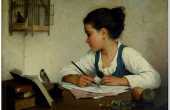Emilie Medland-Marchen
Emilie is a writer, photographer and academic researcher from Calgary, Alberta.
Junior Contributor III
- Sharp-Eyed Citizen
- ?
- Articles
1 - Featured
1 - Comments
3
- Ext. Comments
3 - Processed
3 - Revisions
2
- Topics
3 - Topics Taken
3 - Notes
8
- Topics Proc.
4 - Topics Rev.
1
- Points
303 - Rank
X - Score
139
Latest Articles
Latest Topics
Commodity Fetish in Atonement (2007)In Atonement, much attention is paid to items and their influence on the characters and world around them. This is portrayed through long, wide-angle camera shots that linger on objects such as Robbie's letter, the vase, Cecilia's star hairpin, etc. Address these items from a Marxist perspective, in particular, using the theory of the "commodity fetish". What does the film's focus on these items do for the plot development and narrative? Why is so much attention paid to them? My suggestion is that the items represent the culture of Britain pre and during World War II. As the film progresses, the items reflect the decay of wealth, power and culture in Britain.
|
Polyamory in House of CardsDiscuss the polyamorous marriage depicted between the two lead characters, Frank and Claire Underwood, in Netflix's House of Cards. Is the relationship depicted accurate or contrived? What does this depiction do for the characters on the show? How does the depiction of polyamory on television change society's perception of these relationships?
|
Orange is the New Black as a Patriarchal MicrocosmThe newest season of the popular show, Orange is the New Black, was released last week on Netflix. The show has been creating waves in the media due to its depictions of female relationships, portrayal of the U.S prison-industrial complex, and exploration of sensitive topics such as race, LGBTQ rights, and gender. What hasn't been discussed is the use of the Litchfield Corrections Facility as a microcosm for the greater society. The prison full of female inmates represents the victimization of women in society, and the mostly male correctional officers their oppressors and enforcers. How do the struggles of the women in the prison serve as a representation for a patriarchal society? How is intersectional feminism addressed as a solution to this problem? And are there any solutions offered, or is OITNB simply an unbiased glimpse into the lives of women? These are all topics that could be explored in an in-depth analysis of the show and its overarching themes.
|
Latest Comments
| Sailor Moon Crystal (2014) VS The Original | |
Tommy’s rage is made even more devastating as it directly contrasts the apathy of Kathy and her inability to change the world around her. Tommy’s constant drive to prove that he is truly in love, and thus gain his and Kathy’s sovereignty, drives the later part of the novel. Kathy seems to be a complicit narrator, relaying events that happen to her and other Hailsham students that they are either unable or unwilling to change. But although Tommy’s rage is enough to drive him to attempt to change his own life, it is not enough to drive him to overthrow the oppressive system he lives in. This hits at the heart of the devastating quality of the novel; the combination of Kathy’s apathy and Tommy’s unwillingness to direct his anger results in a desolate world that is loathe to change, and hope itself becomes hopeless. | Ishiguro's Never Let Me Go: The Transformation of 'Letting Go' |
The game industry’s representation of female voices is definitely a problem. But I think the Zelda series does a better job than most to provide complex female voices in its games. The fact that the article was able to provide so many examples of female characters in the Zelda series is evidence that female representation is apparent, though it may not exist beyond stereotypical views of womanhood. Most games definitely pass the Bechdel test (Twilight Princess in particular), and a woman is given a major continuing role within the series (Zelda). Zelda is presented as a well-rounded, interesting character, and I would argue that her representation as a archetypal “Damsel” has changed a lot throughout the series. In Zelda I and II, she was essentially an extension of Princess Peach from the Mario series. In Wind Waker and beyond, she is given a more leading and helpful role. | The Legend of Zelda: Female Representation |

I definitely agree with your complaints about movement and the meshing of 2D and 3D animated sequences. I remember the original Sailor Moon being incredibly vibrant and well animated, in a way that really complimented the characters. There were comical moments with a lot of minimal animated movements, but the control and fluidity that defined the animation of the transformation sequences was really impressive for its time. In Crystal, this fluidity seems stunted, the girls more like walking portraits rather than dynamic, moving characters. I think that’s a stylistic choice, given the extreme change in art style, but it seems like a poor choice given that the Scouts are supposed to be courageous, brave and always in charge. The animation in the original reflected their capability with its dynamacy. With the new style, it seems like their abilities are stunted along with their movement. They don’t seem as capable and courageous as they once did.